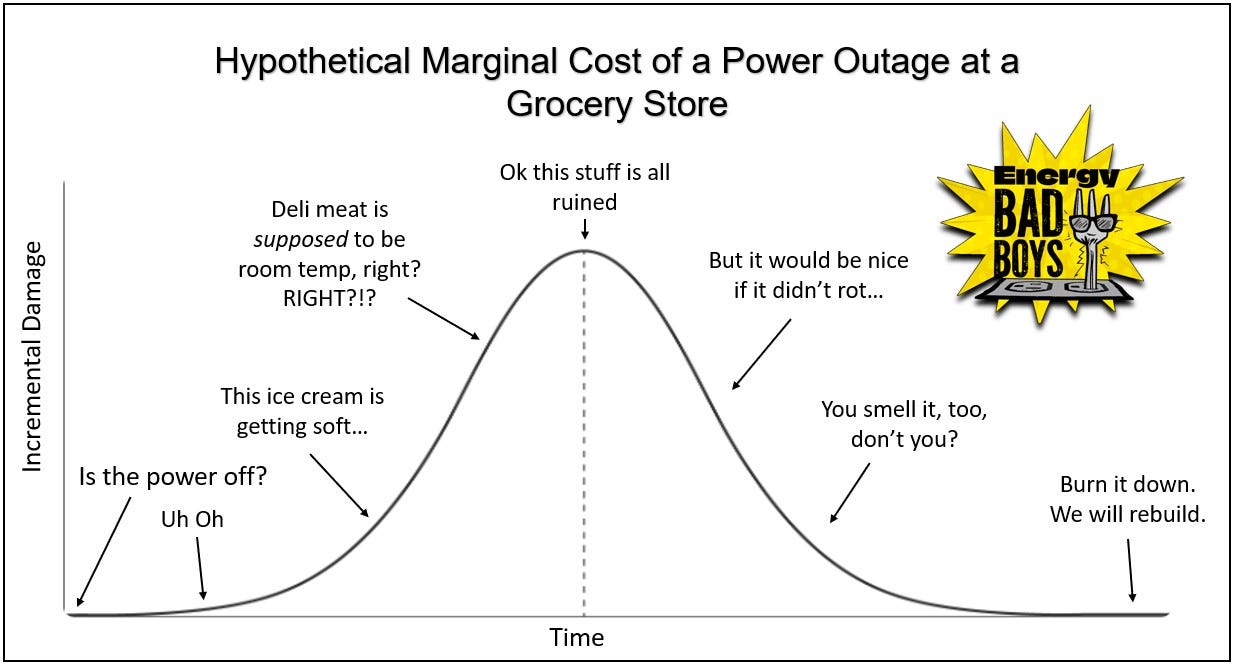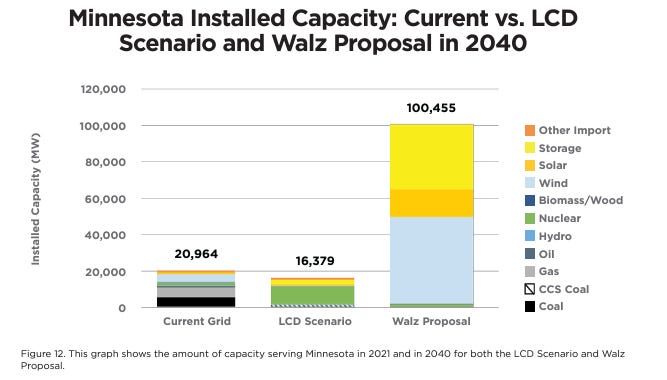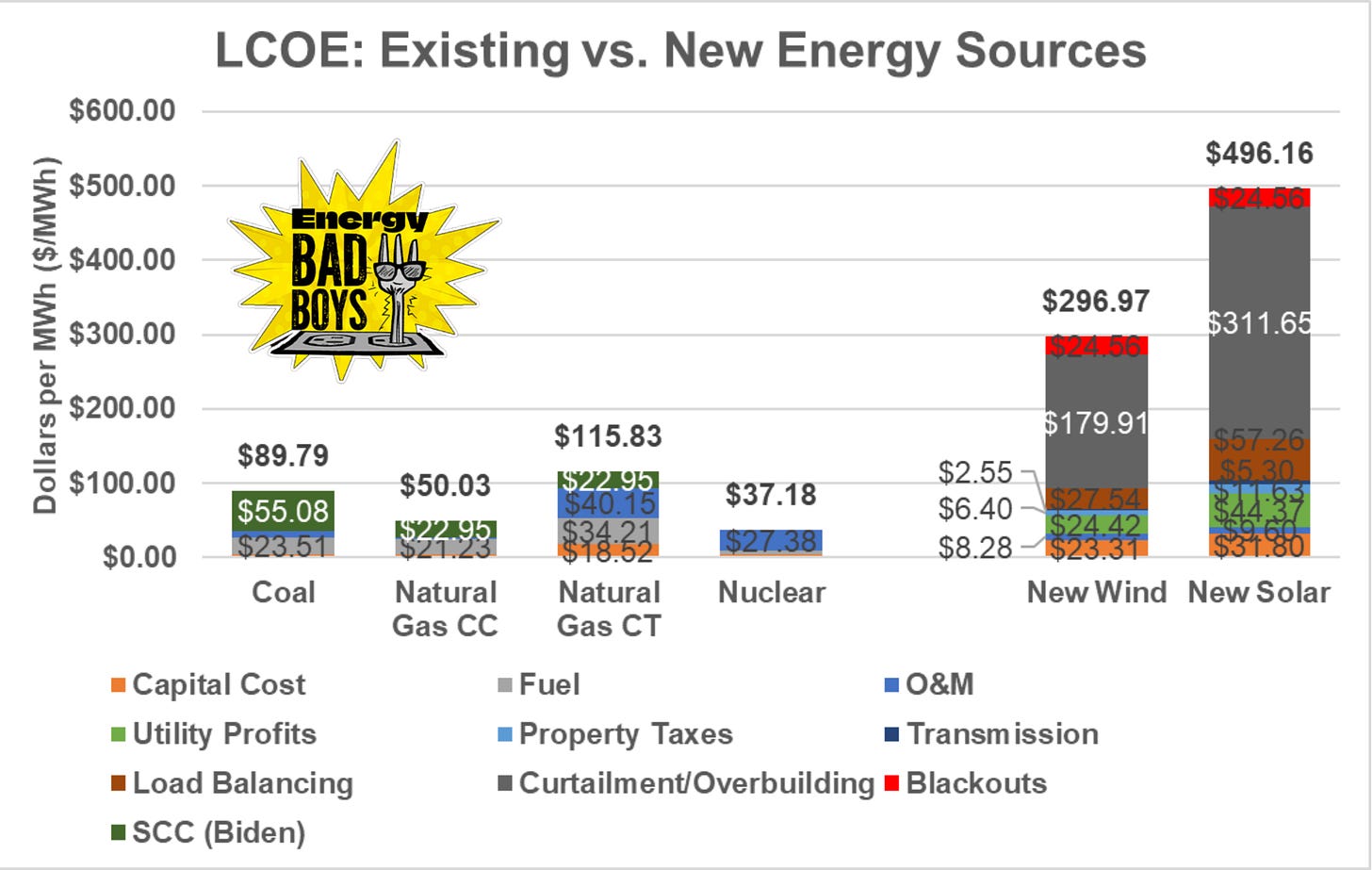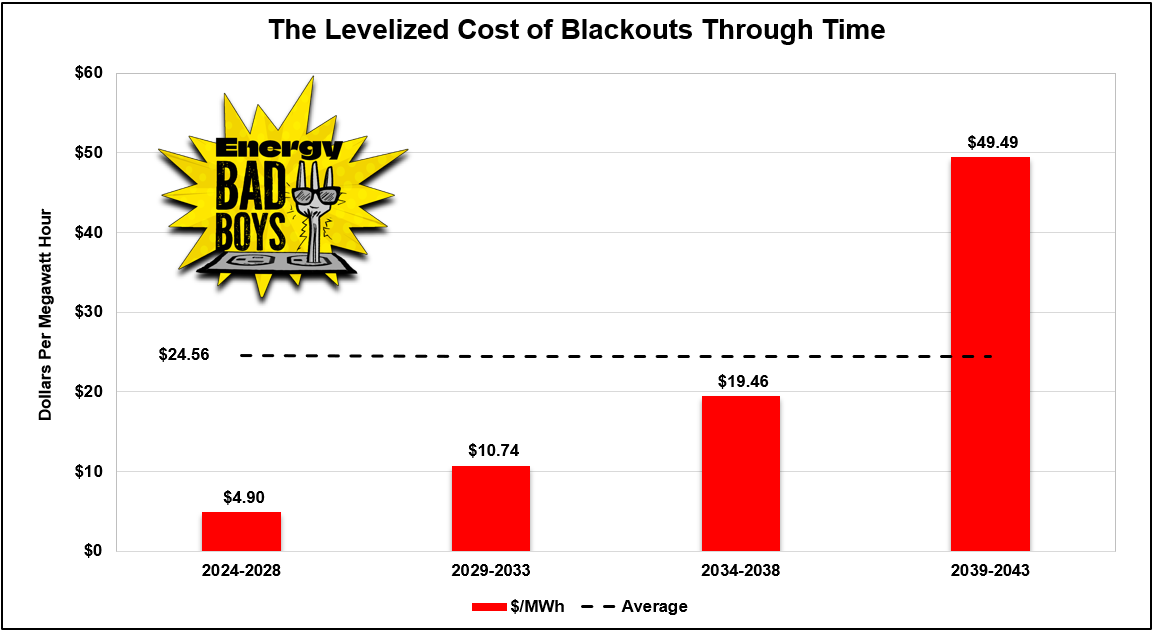Last week, we detailed how power outages at the Niwot Market in Colorado cost the small grocery store $35,000 over the course of 24 hours. By dividing the company’s monetary losses by the number of kilowatt hours (kWh) of electricity that were not consumed, we found the cost per lost kWh was an astounding $12.21.
For context, this is 111 times more than the average cost of electricity for commercial customers in the state, which is 11.67 cents per kWh.
The massive per-unit costs of the blackouts —which equate to a jaw-dropping $12,213 per megawatt-hour (MWh)— piqued our curiosity about performing a thought experiment to calculate a “Levelized Cost of Blackouts” for different energy resources within a specific power system and adding it to our “All-In” Levelized Cost of Energy (LCOE) graph.
The Value of Lost Load
Before we divvy up the cost of blackouts on a per MWh basis, it helps to better understand the costs associated with blackouts and the price people would be willing to pay to avoid them.
According to Jonathan Lesser and Charles Feinstein in their report on preemptive power shutoffs in California, the most common measure used to estimate the value of lost electric service is called the Value of Lost Load (VOLL), which can be thought of as a customer’s willingness to pay to avoid losing electricity for a given period of time.
Lessor and Feinstein write that the VOLL depends on many factors, including the type of customer (e.g., residential, commercial, or industrial), the duration of an outage (in general, VOLL increases as the duration of an outage increases), the time of year, the number of interruptions the customer has experienced, and lost business revenues and equipment damage.
Specific monetary quantification of the VOLL estimates is also difficult to calculate because values are inherently subjective, which is why cost estimates for VOLL can be as low as $11/kWh for residential customers and up to $67.78 per kWh for commercial and industrial users, a range of $11,000 to $67,780 per MWh.
The wide range of VOLL estimates makes a lot of sense, especially when we consider the marginal cost of a blackout for different customer classes. In the case of the Niwot Market, we can probably expect the marginal cost of a blackout to look like the normal distribution in the graph below. If you have questions, comments, or a scathing rebuttal on this graph, please leave a comment at the end of the article.
Other situations are more dire. In the case of the Texas blackouts in 2021, the VOLL was much higher. The economic cost of the deadly blackouts was estimated at $80 billion to $130 billion, while the total lost generation was around 2.6 billion kWh, producing a VOLL between $30.3 and $49.2 per kWh, or $30,300 to $49,200 per MWh.
For households during Uri, the VOLL increased over time as people lost access to heat during frigid temperatures. In cases like these, the longer the blackouts, the higher the cost in terms of loss of life and property damage from frozen pipes.
The Levelized Cost of Blackouts
What happens if we calculate the Levelized Cost of Blackouts due to an overreliance on wind and solar?
For our purposes, we will use our report on Minnesota’s 100 percent carbon-free electricity mandate and the newly proposed VOLL estimates of $10/kWh, or $10,000 per MWh, from the Midcontinent Independent Systems Operator (MISO), the grid operator that serves Minnesota and 14 other states.
In that report, we determined that meeting Minnesota’s future electricity demand with wind, solar, battery storage, and existing nuclear would require a nearly 5x increase in the amount of installed capacity relative to the 2021 grid.
This “reliability,” however, is based on using 2021 hourly electricity demand and wind and solar capacity factors, which means if the weather is ever different than this test year, there may not be enough power to go around.
To model the reliability of this power system during different years, we compared the hourly electricity demand to the generation by the state’s future fleet nuclear, wind, solar, and battery storage capacity installed on the system from 2024 to 2043 using the historic hourly electricity demand and hourly capacity factors for wind and solar in 2019, 2020, 2021, 2022, and 2023.
We then totaled up the number of MWhs of unserved electricity demand, multiplied it by $10,000, and divided it by the total amount of electricity produced by renewable energy sources during the model run to get a Levelized Cost of Blackouts.
These costs were then compared to the cost of coal and natural gas plants, including the Biden Administration’s Social Cost of Carbon estimate for an apples-to-apples comparison of cost.
Even with carbon dioxide externalities added to coal and gas, existing coal is 3.3 times less expensive than wind and 5.5 times cheaper than solar. Natural gas combined cycle plants are six times cheaper than wind and ten times cheaper than solar.
As you can see, the average levelized cost of blackouts for the model run is $24.56 per MWh. This figure grows from only $4.90 per MWh in the early model run years to nearly $50 per MWh by 2040 as more blackouts occur due to an overreliance on intermittent renewable generation. More blackouts obviously mean higher costs associated with power outages.
It is also important to remember that the blackout costs were lower in the earlier years precisely because the reliable coal and natural gas plants that wind and solar advocates love to hate keep the system adequately supplied when wind and solar do not show up to work.
Limitations to the Analysis
Of course, our analysis has limitations. First and foremost, these LCOE estimates are system-specific because they depend on dividing the cost of the system by the amount of electricity consumed over the model run.
However, the biggest limitation, in our minds, is that it assumes that people experiencing blackouts due to the low wind and solar output will not deviate from current policies to prevent them in the future.
We have already seen California and New York delay the retirement of natural gas plants to stave off blackouts; other areas will build new gas capacity, and home generator sales are expected to surge in the coming years. Residents may also purchase generators to keep their lights on.
Our analysis shows what will happen if policymakers decide to double or triple down on running a grid with unreliable energy sources like wind and solar. However, electricity consumers won’t stand for such poor service, and policymakers will need to address these concerns and reevaluate their policies, as has already been the case.
Conclusion
No matter how it’s estimated, the cost of unreliable electricity sources far exceeds that of reliable thermal generators, even when including the externalities of carbon dioxide emissions.
This highlights a major concern with applying the so-called cost of carbon estimates in real life because the economic cost of carbon emissions is far outweighed by the economic cost of increasingly expensive and unreliable electricity service caused by intermittent, weather-based generation stemming from renewables.
In other words, by only accounting for the negative externalities of carbon emissions, we would be underestimating the positive externality of reliable electricity and invite new negative externalities far more costly than carbon emissions.
Thank you for reading Energy Bad Boys! Please like, share, and subscribe.
Sorry, there’s no “What We’ve Been Reading” this week because it’s been a crazy few days for the Energy Bad Boys. Someone stole a car from Isaac’s garage at around 12:30 a.m. Wednesday, and it’s been a hassle to get that sorted out.










I get the feeling the climate alarmists don't think at all about the downstream impacts of the radical changes they are trying to force upon us. I am in transportation and wonder what those impacts will be when they ban the diesel engine. What do you do with 3 million diesel trucks that can no longer be used? Where do you put thousands of rail locomotives if they can no longer be operated? Perhaps just build a rail line out to the desert and build a new "iron mountain" out of all this obsolete equipment. But who knows? With cloud seeding maybe you could turn the mountain into a ski resort.
There is another factor that at least the climate alarmists are missing. Single family homes and businesses have begun adopting and installing home generators. These are rarely if ever "renewable power" but instead are diesel, gasoline, and propane powered. At this point I have 15 kW of my own, plus a truck with a 75 gallon fuel tank that can power the house if need be. When the power goes out now, after Uri, I hear a small fleet of generators kicking on and the lights barely flicker. That cost should probably be factored into your calculations. The real losers in this are apartment dwellers and low income families that can't afford all these extra modifications. Small businesses in commercial strip centers or malls likely don't have the facilities to put in generators, so again the higher density areas are the ones unable to cope. Blackouts are probably racist and should be stopped just for that reason, right?
There are some other costs/effects that I observed during a 24 hour power outage in San Diego. When the traffic lights quit working (within a few hours) there were accidents all over town, some fatal. Also, the same businesses watching their food spoil, discovered that almost none of their customers used cash, so without credit cards, no one was able to do any sales transactions. Of course, most people don't seem to realize that you can't buy gasoline when the power is out, so everyone ran out of gas too. But possibly the worst was when the water in the public water system lost pressure due to inability to pump, and no one had any water supply. That took less than a day to deplete the water in the public system. No flush for you! Solar and wind did nothing because the grid was down. Myself, I had a portable generator, gasoline and water reserves but I was the only place on my block with lights as I grilled steak and drank cold beer on the patio that night. This is what happens when you get accustomed to hurricanes.